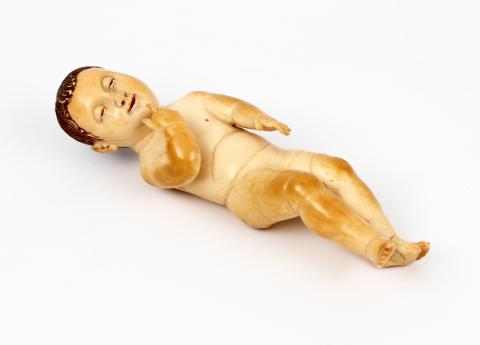Menino Jesus de Camilha
Menino Jesus da Camilha
Marfim com policromia
Nipo-Português, séc. XVII
Com.: 18,0 cm
Prov.: Manuela Lirio, Vila Praia de Ancora
Sleeping Child Jesus
Painted ivory
Japanese-Portuguese, 17th century
Width.: 18.0 cm
Prov.: Manuela Lirio, Vila Praia de Ancora
A seventeenth-century Japanese ivory carved figurine depicting the Sleeping Child Jesus, an example of a group of similar statuettes know has ' Sleeping Child Jesus'.
The child, featuring a more childlike than baby-like anatomy, sculpted all around, is depicted asleep and slightly inclined towards his right. His delicate attitude and serene expression evoke Buddhist representations.
He has wavy hair underlining a high and clear forehead, well-defined ears, an aquiline nose and slightly opened mouth. His body is stretched, his arms and legs short and chubby, as seen from the folds of the flesh, his hands and feet. He has his right arm folded as if he was lifting his thumb on to his mouth.
There are traces of paint on his eyes and mouth.
These small devotional objects were produced in large quantities throughout the sixteenth and seventeenth centuries, in response to a strong demand by the Iberian market.
The fundamental role of the Society of Jesus for these devotional productions must be emphasized a responsible for the conversion effort in Japan, which encouraged the local production of carved figurines as a visual aid to the spread of the Christian faith.
The appearance of this type of carved figurines coincides with the development in Europe of the decorative theme of Italian putti.
Imagem de Menino Jesus deitado, em marfim, trabalho japonês do séc. XVII, que se integra no grupo designado “MeninosJesus de camilha”.
O Menino de vulto pleno, adormecido e ligeiramemente inclinado sobre o seu lado direito, com gestos delicados e expressão serena, sugerindo representação budista. Os cabelos são ondulantes, deixando a descoberto a testa alta, as orelhas bem definidas, o nariz aquilino e a boca ligeiramente entreaberta.
Tronco alongado, braços e pernas curtas e roliças, marcadas por refegos, mãos e pés papudos. o braço direito flectido parece levar o dedo polegar à boca É uma anatomia mais juvenil do que infantil.
Vestígios de pintura nos olhos e boca.
Estas peças devocionais de reduzidas dimensões, foram produzidas em grandes quantidades durante todo o séc. XVI / XVII, devido à enorme procura no mercado ibérico.
É de referir o papel relevante da Companhia de Jesus, grande responsável pela conversão ao cristianismo no Japão, que incentivou a produção local da imaginária com vista à propagação da fé cristã.
O aparecimento deste tipo de esculturas coincide com o desenvolvimento, na Europa, do tema ornamental dos putti italianos.
Bibliografia:
- BARRETO, Luís Filipe, ALVES, Jorge M. dos Santos, Macau, O Primeiro Século de um porto Internacional, 2007.
- A Expansao Portuguesa e a Arte do Marfim, F. C. Gulbenkian e Comissao Nacional para as Comemoraçoes dos Descobrimentos Portugueses, 1991

